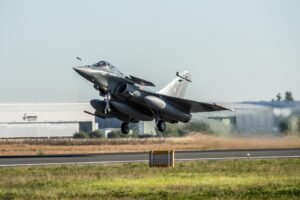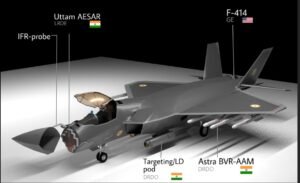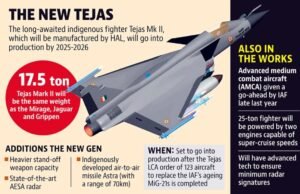THE SKIES OF TOMORROW: WHAT MAKES 5TH GENERATION AIRCRAFT SPECIAL?
- Related toInternal Security, Science & Tech
- Published on8 June 2025
 Have you ever seen a movie with high-tech jets that can almost disappear and perform amazing moves like they’re smart on their own? That seemingly sci-fi technology is closer to reality than you might think. We are currently in the era of 5th generation aircraft, a revolutionary leap in aerial combat that has redefined the meaning of air superiority. These are not just planes; they are flying data hubs, a fusion of stealth, speed, and sophisticated intelligence.
Have you ever seen a movie with high-tech jets that can almost disappear and perform amazing moves like they’re smart on their own? That seemingly sci-fi technology is closer to reality than you might think. We are currently in the era of 5th generation aircraft, a revolutionary leap in aerial combat that has redefined the meaning of air superiority. These are not just planes; they are flying data hubs, a fusion of stealth, speed, and sophisticated intelligence.
The dawn of this era began in 2005 with the introduction of the American F-22 Raptor, a plane that set a new benchmark for what a fighter jet could be. Since then, the race to develop these advanced aircraft has become a global pursuit, with nations like China, Russia, and India investing heavily in their own programs. This article will take you on a journey through the skies of tomorrow, exploring what makes these jets so special and introducing you to the key players in this exclusive club.
What Makes a Fighter Jet ‘5th Generation aircraft’?
So, what exactly elevates a fighter jet to the ‘5th generation’ category? It’s not just about being new; it’s about a specific combination of advanced capabilities that work in synergy to create a truly formidable fighting machine. Let’s break down the key characteristics:

Stealthy as a Shadow: At the heart of a 5th generation fighter is its stealth technology. These aircraft are meticulously designed to have a very low radar cross-section, making them incredibly difficult for enemy air defense systems to detect and track. This is achieved through a combination of sleek, angular designs, radar-absorbent materials, and internal weapons bays that hide missiles and bombs from radar waves until the moment of launch.
Super Fast, Super Efficient (Supercruise): One of the defining features is the ability to sustain supersonic flight—flying faster than the speed of sound—without the use of afterburners. This capability, known as ‘supercruise’, allows these jets to cover vast distances at high speeds while conserving precious fuel, giving them a significant advantage in terms of operational range and engagement time.
Advanced Avionics and Sensor Fusion: Think of a 5th generation fighter as a flying supercomputer. It is equipped with a vast array of advanced sensors, including sophisticated AESA (Active Electronically Scanned Array) radars. What truly sets it apart is ‘sensor fusion,’ the ability of the onboard computers to take in data from all these sensors, process it, and present the pilot with a single, unified, and easy-to-understand view of the battlefield. This gives the pilot unparalleled situational awareness.
Networked Capabilities: These jets are not lone wolves. They are designed to be part of a larger network, seamlessly sharing vast amounts of data with other aircraft, ground forces, naval assets, and even satellites in real-time. This ‘network-centric’ approach transforms the jet from a single weapon platform into a critical node in a combined arms operation, multiplying the effectiveness of the entire force.
Agile and Nimble (Maneuverability): While stealth is crucial for getting close, high maneuverability is key to winning a dogfight and evading threats. 5th generation fighters often feature advanced aerodynamic designs and thrust-vectoring engines that allow them to perform breathtaking aerial maneuvers that are impossible for older generation aircraft.
The Global Race for 5th Generation Air Superiority
The development of 5th generation fighter aircraft is a monumental undertaking, requiring immense technological expertise and financial investment. As a result, only a handful of nations are currently operating or developing these advanced machines. Let’s take a look at some of the most prominent aircraft in this elite category.
United States: The Pioneers – Lockheed Martin F-22 Raptor
The F-22 is the world’s first operational 5th generation fighter and is widely regarded as the benchmark for air dominance. Its combination of stealth, supercruise, and advanced avionics makes it a formidable opponent. However, its high cost and a U.S. ban on exports have limited its production, making it a rare and exclusive asset of the U.S. Air Force.
- Lockheed Martin F-35 Lightning II: The F-35 is a more versatile and widely adopted 5th generation fighter. It comes in three variants to suit different operational needs: conventional take-off and landing (F-35A), short take-off/vertical landing (F-35B), and a carrier-based version (F-35C). Its advanced sensor fusion and network capabilities provide the pilot with unparalleled situational awareness. The F-35 has become a cornerstone of many allied air forces around the world.
China: The Prolific Contender – Chengdu J-20 (Black Eagle)
The J-20 is China’s premier 5th generation multi-role fighter. Characterized by its long and blended fuselage and canard-delta configuration, the J-20 emphasizes stealth and long-range strike capabilities. Its entry into service marked a significant leap for China’s indigenous aerospace industry, positioning it as a key player in the 5th generation landscape.
- AVIC J-35 (FC-31 Gyrfalcon): China’s second 5th generation stealth fighter, the J-35 is a twin-engine, single-seater aircraft with an emphasis on air superiority and surface strike. It is being developed into a navalized variant for China’s aircraft carriers, which could make China the only country besides the U.S. to operate two types of stealth fighters.
Russia: The Resilient Power – Sukhoi Su-57 (Felon)
The Su-57 is Russia’s answer to the 5th generation challenge. It is a multi-role stealth aircraft designed for both air superiority and attack roles. The Su-57 combines stealth, supermaneuverability, and supercruise capabilities, making it a highly agile and potent aircraft. Its estimated unit cost is significantly lower than its Western counterparts, making it an attractive option for export.
India: The Aspiring Power – HAL AMCA (Advanced Medium Combat 5th Generation Aircraft)
India has cleared the ambitious Advanced Medium Combat Aircraft (AMCA) project—its first indigenous fifth-generation stealth fighter jet. Approved by Defence Minister Rajnath Singh, the project marks a major step in boosting India’s defence self-reliance and aerospace capabilities.
Developed by the Aeronautical Development Agency (ADA), AMCA will operate alongside the Tejas fighter and form the future core of the Indian Air Force.
The AMCA is designed as a medium-weight, twin-engine aircraft equipped with advanced stealth features, AI-assisted systems, internal weapons bays, and long-range strike capabilities. With a fuel capacity of 6.5 tonnes and a 1,500 kg payload in its internal bay, it combines reach with stealth. The initial phase will involve full-scale development of five prototypes, with an estimated cost of ₹15,000 crore.
Globally, AMCA will stand alongside elite jets like the F-35 (USA), Su-57 (Russia), and J-20 (China)—each known for cutting-edge stealth and combat tech. While these aircraft have matured, India’s AMCA prioritizes strategic autonomy over dependence on foreign defence supplies.
-
Fifth-generation features: stealth, AI, advanced avionics, internal weapon bays.
-
Part of a broader push alongside LCA Mk II, VSHORAD, and MPATGM systems.
More than just a jet, the AMCA reflects India’s growing ability to design, build, and control the next generation of airpower—on its own terms.
Other Key Players
Several other nations are also making strides in the development of advanced fighter aircraft:
-
South Korea (KAI KF-21 Boramae): The KF-21 is a multi-role fighter project that aims to replace South Korea’s aging fleet of F-4s and F-5s. While sometimes referred to as a ‘4.5 generation’ fighter, it incorporates many advanced features found in 5th generation aircraft.
-
Japan (Mitsubishi F-X): Japan is developing its own 5th/6th generation air superiority fighter, the F-X. This program represents Japan’s commitment to maintaining its air superiority capabilities independently.
-
Boeing-Saab T-7 Red Hawk: While primarily an advanced jet trainer, the T-7 Red Hawk is designed to prepare pilots for the complexities of flying 5th generation fighters, incorporating a glass touchscreen cockpit and advanced mission systems.
A Collaborative Project of the Past It’s also worth noting the HAL Sukhoi PMF/FGFA, a planned collaborative project between Russia and India based on the Su-57. While the project was eventually canceled due to various disagreements, it represented an ambitious effort to create a customized 5th generation fighter tailored to Indian requirements.
A Comparative Look at 5th Generation Aircraft:
To provide a clearer picture of these advanced machines, here is a table summarising the key players in the world of 5th-generation fighter aircraft:
| Rank | Name | Country | Year | Description |
|---|---|---|---|---|
| 1 | AVIC J-35 | China | 2028 | 5th Generation Carrierborne Fighter |
| 2 | Boeing-Saab T-7 Red Hawk (eT-7A) | USA / Sweden | 2023 | 5th Generation Advanced Jet Trainer Aircraft |
| 3 | Chengdu (AVIC) J-20 (Black Eagle) | China | 2017 | Multirole 5th Generation Fighter Aircraft |
| 4 | HAL AMCA (Advanced Medium Combat Aircraft) | India | 2030 | 5th Generation Fighter Concept |
| 5 | HAL Sukhoi PMF/FGFA | Russia / India | 2019 | Multirole 5th Generation Fighter Concept |
| 6 | HESA F-313 Qaher (Conqueror) | Iran | 2018 | 5th Generation Lightweight Stealth |
| 7 | KAI KF-21 Boramae (KF-X) | South Korea | 2028 | 5th Generation Multirole Fighter Aircraft |
| 8 | Lockheed Martin F-22 Raptor | USA | 2005 | 5th Generation Air Dominance Fighter |
| 9 | Lockheed Martin F-35 Lightning II | USA | 2016 | Advanced Multi-Role Strike Fighter / Fighter-Bomber Aircraft |
| 10 | Mitsubishi F-X | Japan | 2035 | 5th/6th Generation Air Superiority Fighter |
What Are 5th Generation Fighter Jets?
- Stealthy, networked, and AI-integrated aircraft
- Blend of speed, stealth, agility, and smart tech
Core Features
- Stealth: Nearly invisible to radar
- Supercruise: Supersonic flight without afterburners
- Sensor Fusion: Unified battlefield awareness
- Network-Centric Warfare: Real-time data sharing
- Extreme Maneuverability: Advanced thrust-vectoring
Global Leaders in 5th Gen Fighters
- USA: F-22 Raptor, F-35 Lightning II
- China: J-20, J-35 (carrier-capable)
- Russia: Su-57 (Felon)
- India: HAL AMCA (in development)
India’s AMCA Highlights
- First indigenous 5th gen stealth fighter
- Stealth, AI, internal weapons, and long-range strike
- Focus on defence self-reliance and strategic autonomy
Other Emerging Players
- South Korea: KF-21 Boramae
- Japan: Mitsubishi F-X
- USA/Sweden: T-7 Red Hawk (trainer)
Former Projects : India-Russia FGFA- Cancelled Su-57 variant plan
The Bigger Picture- These jets are not just planes, they are nodes in digital warfare. 5th gen marks the future of aerial combat and air superiority
Loved this article? Go to Learning EDGE+ Page↗️


